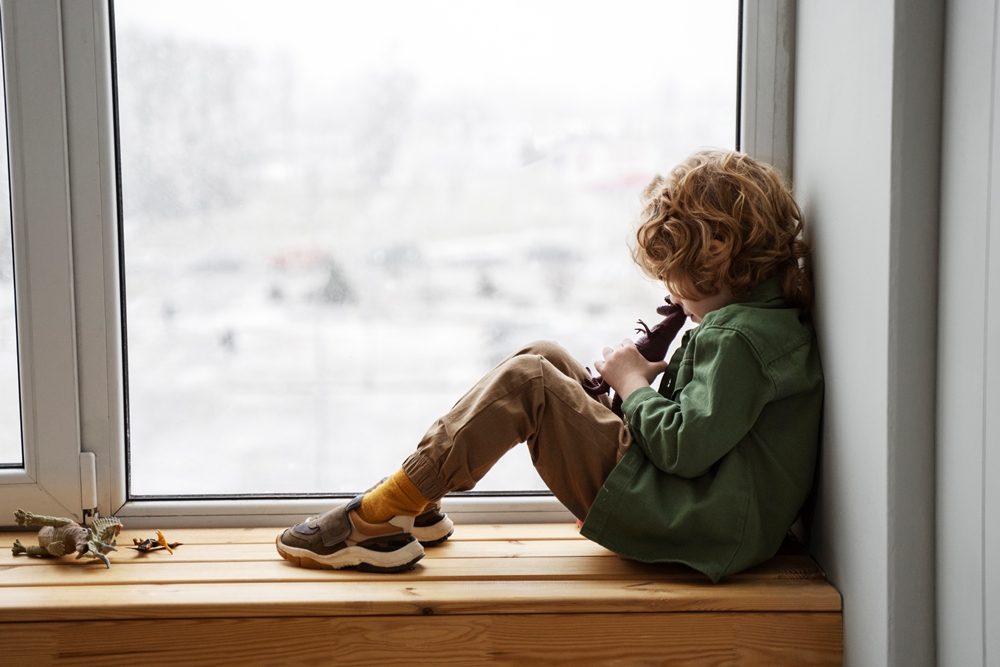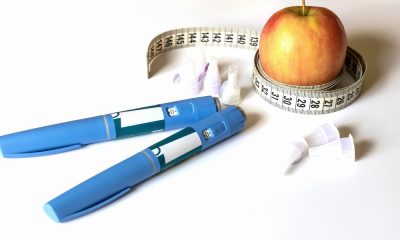Insights
How Connected Care Technology supports older people to live independently for longer

Paul Berney, CMO at Anthropos, explores how connected care technology can improve older people’s lives.
Within Connected Care, we are all working towards the same goal; enabling older people to maintain their independence for longer. One way of achieving this is by pioneering new technologies that support better understanding of the needs of older people.
The 2021 Census confirmed what many of us who work within the Connected Care sector have long known; our population is ageing. Over the past 10 years, the percentage of people aged 65 and older has risen from 16.4 per cent to 18.6 per cent in the UK. In addition to this, life expectancy in the UK has also increased by an average of one year since 2010. This means that, on average, men are living until 79 years old, and women until 80 years old. Our ageing population is coupled with a falling birth rate, which, in 2020 hit the lowest level recorded since 2002 with 613,936 live births recorded.
This data reflects the simple fact that within the UK we will have more older people living for longer, but there may be fewer people to care for them. We are already seeing reports of the unsustainable pressures facing the NHS, which are stemming from workforce shortages. However, these pressures will only grow as we have more older people in society, which will inevitably lead to further pressures placed on every part of the care continuum.
Currently, many older people who live at home are reliant on routine health checks to detect changes in their wellbeing. This is due to the fact that the technology used to support older people in their homes has for many years been restricted to reactive, telecare solutions. But as the care system struggles to cope with the volume of people it needs to support, a switch to proactive and preventative methods would support both the delivery of better care and the creation of better care outcomes for older people and their families.
The role of technology and its impact on health care expectations

Over the past 20 years, technology has advanced to a point where, for many, it is fully integrated into everyday life. Throughout this period, we have seen developments to home care solutions that aid physical mobility including stair lifts and handrails. However, we have seen a lack of integration of digital technologies into care solutions. But, it is a fallacy that older people are opposed to or uncomfortable with technology. Today’s older people have witnessed the creation of the digital age and many have become accustomed to technology supporting them in a variety of ways throughout their middle and later life.
I believe that those experiences of technology have led to a change in expectations for both older people and their families. For example, we know it is now possible for a watch to detect the number of steps someone takes and deliver reminders to move when it has detected sedentary periods of the day. This technology can be adapted for older people. A quick Google search will pull up a huge number of responses explaining how these devices can best be used for older people, and the best way to understand the data that comes from them.
While awareness of wearable technology is growing, less is known about the kinds of passive technologies that are used in Connected Care to build a picture of someone’s life.
How do Connected Care Platforms work?
Connected Care Platforms use the data collected from sensors installed around a home that monitor the environment that people are living in, their daily routine and patterns of behaviour, alongside their physiological wellbeing and their safety and security. These sensors collect data, which is transferred to a cloud-based platform where it is analysed and processed, before being turned into intelligence. This intelligence is shared with family and carers to help them to build a more complete understanding of what goes on inside the home when they are not there. Once you have better intelligence about someone’s care needs you can make better informed decisions about their care. This constant monitoring is so much more powerful than making decisions based on a snapshot of someone’s life.
Connected Care Platforms, like Anthropos, can build on that understanding of an older person’s patterns of behaviour through analysing trends over time. Simply put, we see changes in someone’s daily routine that may not be visible to others. The older person themselves may not be aware of changing sleep patterns or activity levels. Connected Care Platforms provide families and carers with an evidence base to inform better decisions to be made. This information also allows different conversations to be had between carers, family members and older people in order to identify the care which they truly need.
Once you build an understanding of the normal day to day behaviour of older people, it becomes easier to identify anomalies which could be indicators of a decline in wellbeing. For example, if an older person boiled their kettle repeatedly, Anthropos could alert the carer to this as a potential sign of cognitive decline. Or, if an older person was to fall in their home, the platform could flag a lack of movement to a carer. With this knowledge, the carer can then organise proactive care solutions to improve conditions that may have gone unnoticed or worsened over time.
How Connected Care technology helps carers and family members

For many people with ageing parents, the reality is that they can’t physically check up on them as much as they would like. Our research shows that 51 per cent of people aged 40 years old would like an update on their parents’ wellbeing at least once a day, and 67 per cent of people aged 40 years old think their parents would be open to having Connected Care technologies installed as it allows safety to be ensured in a non-intrusive way.
One customer told us that having Connected Care “gives a bit of relief I think, especially with having the app on the phone, because we can keep checking it. I am so used to them saying they are fine, they’re coping, but they aren’t. I can see for myself they’re not”.
As we are faced with an increasing number of older people in the UK, it is clear that the need for innovative care solutions will only grow. Connected Care proposes an intelligent solution to the challenges faced by the sector. The ability for Connected Care technology to become predictive allows older people, their carers and family members to take their wellbeing into their own hands. This technology stops issues from occurring by giving carers the ability to provide meaningful care when it is needed, rather than in the aftermath of an injury or illness.
Connected Care technology offers a discrete solution to this problem whilst, more importantly, allowing older people to maintain their independence in a place of their choosing for longer.
News
Childhood loneliness linked to increased risk of dementia, study finds

Childhood loneliness increases the risk of dementia in later life, according to new research.
Adults who recalled being lonely and without a close friend in childhood faced a 41 per cent higher risk of developing dementia, even if they were no longer lonely as adults.
People who frequently felt lonely without close friends during youth showed accelerated cognitive decline — a worsening of memory and thinking — and started middle age with lower scores on these skills.
Researchers from universities in China, Australia and the US, including Harvard and Boston universities, analysed data from 13,592 Chinese adults tracked from June 2011 to December 2018.
The critical factor was the subjective feeling of loneliness itself. Those who reported often feeling lonely as children had a 51 per cent higher dementia risk, even if some had close friends.
However, those who only lacked close friends but did not feel lonely showed no significant difference in risk.
Nearly half of roughly 1,400 adults in the study reported being lonely and without close friends during childhood.
The 4.2 per cent who experienced both faced the highest risk of cognitive decline.
The link to dementia remained strong even for people who were no longer lonely in adulthood, suggesting early-life isolation can have lasting effects on brain health.
During childhood, the brain develops rapidly and is vulnerable to harm. Loneliness acts as a chronic stressor, flooding the developing brain with harmful hormones that can damage memory centres, and it reduces stimulation from social play and peer interaction that helps build robust neural networks.
A separate 2024 study of more than 10,000 older adults found that specific childhood hardships — including poverty, disruptive home environments or parental addiction — were directly linked to poorer cognitive function later in life.
Youth loneliness appears to be rising, partly linked to widespread social media use.
Among girls, 64 per cent aged five to seven, 67 per cent aged eight to 10, and 73 per cent aged 11 to 13 reported feelings of loneliness last year. More than a quarter of boys aged 11 to 17 in the US report feeling lonely.
Children face growing social isolation, with one in four Americans now eating every meal alone — a rate that has surged by over 50 per cent since 2003. Sharing meals with friends and family helps build bonds and positive memories in youth.
Fewer children are playing outside or joining team sports.
A recent study reported that one in three children do not play outside on school days, and one in five do not do so even at weekends.
The 2024 research found a direct, dose-dependent relationship between childhood adversity and cognitive problems in adults — the greater the early trauma, the greater the later risk.
For each significant increase in early trauma, individuals faced an eight per cent higher risk of daily memory issues and scored lower on objective tests of mental speed and focus.
News
Don’t miss you essential monthly agetech update

Your essential monthly update on agetech’s progress
Welcome to your monthly snapshot of the facts, figures, opinions, trends and challenges shaping the development of agetech.
Our new monthly tracker report aims to provide an concise update for busy agetech professionals on the many factors influencing your work.
Here you will find a concise breakdown of deals, developments and opportunities from the last 30 days; and insight and opinion from leading thinkers in the field.
We hope you find something useful and/or inspiring below – and welcome any feedback about what else you’d like to see included.
News
Snoring, silence, and the menopause taboo: The hidden health crisis affecting millions

By Professor Ama Johal, clinical lead and dental sleep expert at Aerox Health
During menopause, it’s very common for women to notice significant changes to their sleep patterns and experience things like restless nights, loud snoring, or simply waking up feeling exhausted.
What most don’t realise, however, is that these symptoms can signal something far more serious – obstructive sleep apnoea (OSA), one of the most impactful and consequential sleep-related breathing disorders.
Women across the world are unknowingly fighting an uphill battle. Around 90 per cent of females with moderate to severe sleep apnoea remain undiagnosed.
This collective lack of awareness is due to a plethora of factors including archaic taboos around the subject and lack of education or omission of menopause in sexual education.
Ultimately, this combination leaves women underprepared and vulnerable to the biological, social and medical realities associated with the menopause.
Now more than ever, we must confront this silence head-on and recognise the hidden sleep crisis affecting so many women globally and the opportunity to address it.
The hidden sleep crisis
Snoring that develops or worsens during menopause can progress into OSA due to a decline in estrogen and progesterone which reduces muscle tone in the throat and in turn makes the obstruction or collapse of the airways more likely during sleep.
Yet this link between menopause and sleep disorders remains largely overlooked, leaving millions of women undiagnosed, untreated, and unaware that their sleep struggles are more than just “part of getting older”.
In my practice, I see the consequences of this misunderstanding far too often.
I hear from many female patients who have been suffering in silence, without the knowledge that they could seek help. In fact, I often encounter the common misconception that snoring is a man’s issue.
This preconceived notion perpetuates a persistent gender bias in sleep-related health research.
As ENT consultant and sleep surgeon at University College London hospitals, Ryan Chin Taw Cheong recently highlighted, the development of snoring is reason enough to consult your doctor. It’s time for this pervasive issue to emerge from the dark.
So why don’t women seek help?
When considering why many women do not seek help for their symptoms, there are two overarching reasons.
Firstly, the information and knowledge is not widely available for sufferers to realise that snoring can be a medical issue which can be assessed and subsequently readily treated.
Secondly, there is a potent stigma surrounding both the menopause and snoring which is an inhibiting factor amongst sufferers, discouraging open discussion.
Perhaps unsurprisingly, menopause is not included in traditional sex education in schools. Being unaware of what is ‘normal’ and what could require medical attention is widespread amongst my patients with sleep disorders, yet this information is not freely disseminated outside of clinics.
Unfortunately, cognitive fog and irritability – symptoms of snoring and obstructive sleep apnoea – are too often written off as stress, anxiety or ‘just the menopause’.
Avoiding sharing symptoms with medical providers, combined with online misinformation, often results in individuals suffering in silence or worse, turning to unregulated miracle menopause cures that exacerbate the risks of undiagnosed OSA.
These so-called ‘cures’ reinforce the harmful notion that the menopause is a defect which needs to be fixed rather than a natural life stage.
The health costs of ignoring snoring
A breadth of research links untreated OSA to cardiovascular disease, hypertension and cognitive decline.
However, aside from the medical risks, snoring and sleep apnoea can have profound social and emotional consequences.
For women, the shame in snoring, a symptom often mischaracterised as a ‘male issue’, can significantly affect self esteem and mental health.
Partners may also suffer if the snoring is disruptive to their sleep, in some instances causing rifts in relationships and a phenomena known as ‘sleep divorces’ (sleeping in separate beds or rooms).
In fact, according to a recent study commissioned by 32Co, 47% of recently divorced Brits cite interrupted sleep linked to snoring or sleep disorders as contributing to their relationship breakdowns, with 85 per cent believing ‘sleep divorces’ contributed to ultimate separation.
Sleep specialists seek to manage and monitor the symptoms of sleep disorders and OSA to minimise disruption to an individual’s personal and public life.
Screening menopausal women for OSA is a preventative measure which leads to informed patients. It is not simply about getting better sleep but about the long-term health outcomes.
Breaking the silence: what needs to change
Drawing on the stories of those I meet in my clinic, I would like to outline five steps that we can take to address this silent epidemic.
First, the menopause and associated symptoms should be included in a comprehensive sex and health education.
This could be provided both in schools’ curricula and made readily available at health services catering to adults.
Second, throughout the course of history women’s issues have been chronically underserved.
More resources can be funnelled into conducting research to help us better understand the impact of the menopause on women’s physical and mental health.
Future research would also help to neutralise the gender bias of previous studies.
Third, launching public health campaigns and workplace initiatives to encourage employers to recognise sleep disorders as a significant element of menopause will help build awareness and reduce the impact of stigmas.
Fourth, myth-busting, shattering taboos, and normalising discussion about the menopause will be key.
We must view snoring as a gender neutral issue rather than a male stereotype and denounce harmful rhetoric and jokes that perpetuate stigma.
Fifth, we must better equip more localised healthcare providers up and down the country to both diagnose and treat OSA effectively.
Sleep disorders are not niche issues but a major public health concern with potentially severe consequences.
Quality of life amongst my patients is inextricably linked with sleep quality.
Recognising the relationship between snoring and OSA and the menopause is not simply about pathologising a natural stage of life, but providing women with the information, respect and medical care they deserve.
Only through more transparency and collaboration amongst researchers, educators and clinicians can we hope to close the gender gap in sleep medicine and bring this hidden crisis to light.

 Wellness1 month ago
Wellness1 month agoGlasgow clinic launches Alzheimer’s detection test

 News3 weeks ago
News3 weeks agoUK aims for 92 per cent dementia diagnosis by 2029

 News5 days ago
News5 days agoOne in 20 children has high blood pressure, study finds

 News1 month ago
News1 month agoRoundup: Atlas maps molecular fingerprints of health, disease and ageing

 Insights3 weeks ago
Insights3 weeks agoAddressing the rising burden of benign prostatic hyperplasia with minimally invasive treatments to tackle healthcare pressure

 News2 months ago
News2 months agoTool could detect early signs of Alzheimer’s

 News4 weeks ago
News4 weeks agoYounger Britons more worried about dementia than older generations, new poll reveals

 News1 week ago
News1 week agoNHS issues heart valve plea after donations dip

































